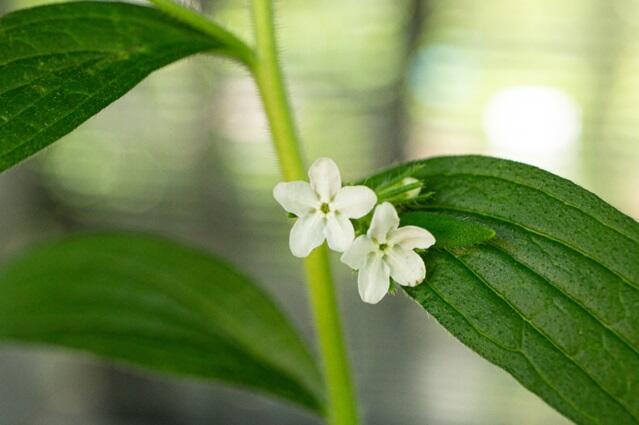Murasaki, a native gromwell plant that produces a natural dye, is also used as a natural medicine. The skin of the roots of this plant contains shikonin, a natural pigment that was used as the purple dye for the uniform garments of the highest-ranking officials of the 12-rank system in the Asuka Period of Japan. Unfortunately, murasaki is an endangered species, and it can be easily crossbred with non-native gromwells, which are effective at reproduction. In fact, some seed suppliers are suspected to be selling allegedly crossbred species under the name murasaki. Continual crossbreeding could lead to the extinction of murasaki and the loss of traditions associated with the plant. However, Japan currently does not have any standard means to guarantee the authenticity of Japanese murasaki.
The research group of Project Assistant Professor Emi Ito at the Institute for Human Life Science at Ochanomizu University and Assistant Professor Ryosuke Munakata and Professor Kazufumi Yazaki of the Research Institute for Sustainable Humanosphere at Kyoto University wanted more people from the general public and other researchers to notice the current dangerous situation and importance of murasaki. Additionally, they have been carrying out genome analyses of native murasaki species from all over Japan. They are planning to compare those species with non-native species to search for marker genes. Their results were published in the international academic journal Plant and Cell Physiology on May 18th, to commemorate Fascination of Plants Day.

Their research is said to have been inspired by studies carried out by Director Hirokazu Matsukawa of the Curatorial Research Office at Kyushu Historical Museum on wooden tablets found in an ancient governmental building in the city of Dazaifu, Kyushu.
According to records from the Nara Period, the Imperial Court ordered people to plant murasaki all over Japan and collected the crop as chō, one of the levies at the time. The chō collected from the Kyushu Region was gathered at Dazaifu. A number of wooden tablets, which were attached to the articles transferred to Dazaifu, have been excavated and designated as important cultural property. Among those wooden tablets, the ones concerning murasaki (described as "purple plant") have been the most frequently found in the excavations. This shows us that the Imperial Court placed great importance on murasaki. However, the number of these plants has been decreasing considerably since the Meiji Era.
Murasaki is especially vulnerable to cucumber mosaic virus, which may have been spread through globalization after the Meiji Era. Once infected with the virus, murasaki stops growing and subsequently withers and dies. Another issue is that murasaki does not germinate easily, and it is not a gregarious plant.
Murasaki blooms with picturesque small white flowers and contains shikonin derivatives in its roots. By contrast, non-native gromwells bloom small cream-colored flowers and contain only a few shikonin derivatives. Despite their differences, they are both believed to be easily influenced by the environment and discriminating them on the basis of their appearances can be difficult. The more frequently that murasaki crossbreeds, the smaller the amount of shikonin derivatives will be produced.
As murasaki is a highly popular traditional plant, a number of regions in Japan have been implementing restoration projects. However, it is currently impossible to prove that the species cultured in those regions are not crossbreeds. The Musashino Region used to be a famous cultivation area in the Edo Period. However, the seeds ceased to germinate in one of the years, and the plants eventually went extinct. Currently, the "Mitaka Gromwell Restoration Project" is ongoing in this region.
For example, murasaki may be planted in some herb gardens attached to a college or university or cultured in only a small amount by farmers. The farmers who keep growing the plant, as well as those managing a restoration project, are said to have a specific need: "We want official approval."
In the 1970s, Kyoto University established a culture system for murasaki. They transferred the plant to their culture medium and grew it in the dark, allowing shikonin derivatives to be produced. A system for multiplying the plant using cloning technology is already in place. What is needed now is a technology to identify purebred lines. Although the cultured cells are red, the aluminum in camellia ash (used as the mordant to dye treads and fabric) turns purple.
The research group has been trying to develop a DNA marker to discriminate the purebred lines and thus define murasaki in Japan. The researchers believe that once their goal is achieved, the protection of purebred lines of murasaki, which has been one of the mainstays of traditional Japanese culture, will be realized. Moreover, they are expecting that the long history of murasaki, which has been cultured since the times of Heijokyo (one of the historical capitals in Japan), will be revealed through decoding of the genome.
This article has been translated by JST with permission from The Science News Ltd. (https://sci-news.co.jp/). Unauthorized reproduction of the article and photographs is prohibited.




